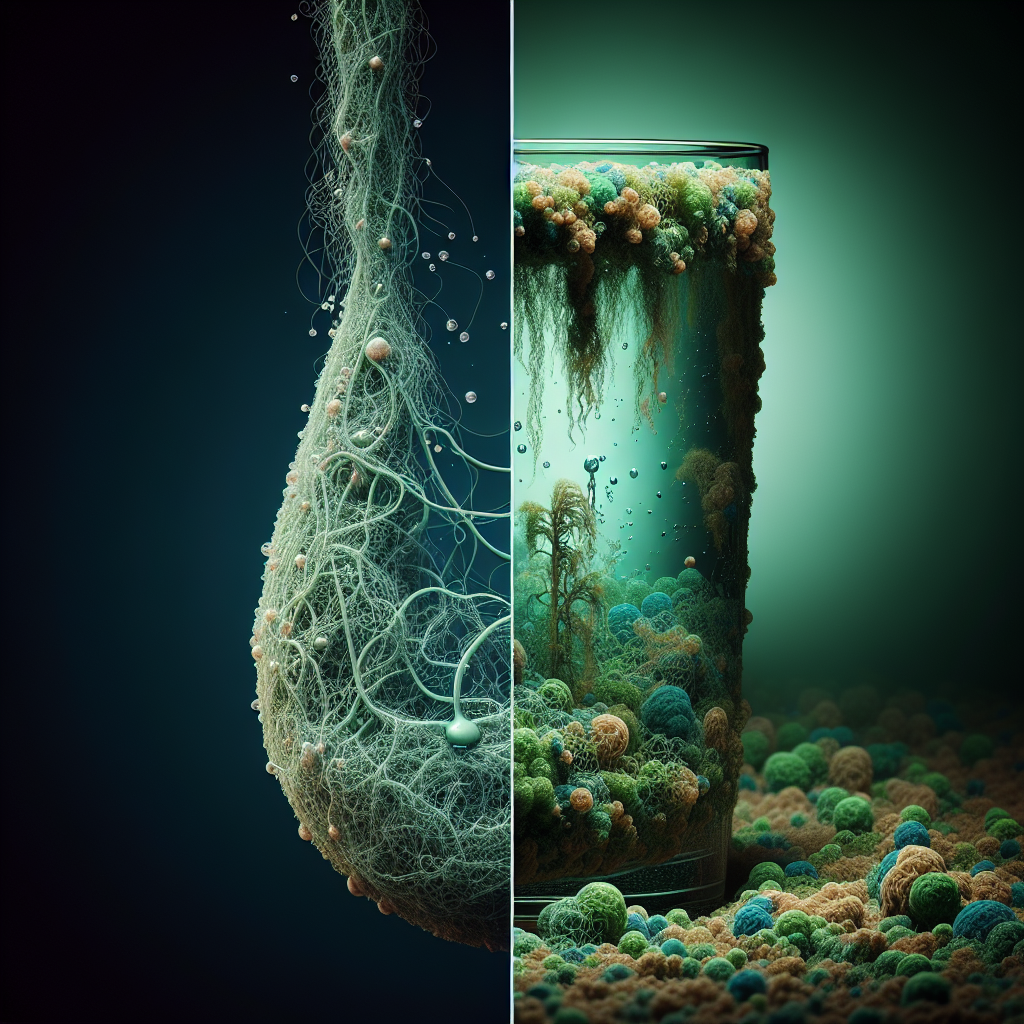Imagine enjoying a refreshing glass of well water on a hot summer’s day, only to discover later that it contains excessive algal toxins. While these toxins may sound harmless, they can pose serious health risks if consumed in large amounts. In this article, we will explore the potential dangers of excessive algal toxins in well water and the steps you can take to ensure the safety of your drinking water. So sit back, relax, and let’s dive into the world of algal toxins in well water together.

Potential Health Risks
Algal toxins and their effects on human health
Excessive algal toxins in well water can pose a variety of health risks for individuals who consume or come into contact with contaminated water. Algal toxins are produced by certain types of algae, such as blue-green algae or cyanobacteria, and can be harmful when ingested, inhaled, or even when they come into direct contact with the skin. These toxins have the potential to cause a range of health effects, including gastrointestinal issues, respiratory problems, skin irritation, and even neurological damage in severe cases. It is essential to be aware of the potential health risks associated with algal toxins in well water and take necessary precautions to prevent exposure.
Types of algal toxins commonly found in well water
There are several types of algal toxins that are commonly found in well water. Some of the most frequently detected algal toxins include microcystins, anatoxins, saxitoxins, and cylindrospermopsins. Microcystins are one of the most common and well-known algal toxins and can cause liver damage and other health issues. Anatoxins can affect the nervous system and cause symptoms like muscle weakness and vomiting. Saxitoxins are known for their ability to cause paralytic shellfish poisoning, while cylindrospermopsins can result in liver damage and gastrointestinal symptoms. Understanding these different types of algal toxins is crucial for identifying and addressing the potential risks associated with them.
Health risks associated with drinking water contaminated with algal toxins
Drinking water contaminated with algal toxins can have significant health implications. The toxins can enter the body through ingestion, leading to various health risks like gastrointestinal problems, liver damage, and neurotoxic effects. Common symptoms of algal toxin ingestion may include diarrhea, nausea, vomiting, abdominal pain, and headaches. In severe cases, individuals may experience more severe symptoms such as seizures, respiratory distress, or even organ failure. Additionally, certain algal toxins have been linked to the development of long-term health conditions, including liver cancer and neurological disorders. It is crucial to understand and address the health risks associated with drinking water contaminated with algal toxins to protect public health.
Contamination Sources
Natural sources of algal toxins in well water
Algal toxins can originate from various natural sources, which can contaminate well water. One of the primary natural sources is the presence of certain types of algae, such as cyanobacteria, in freshwater sources like lakes, ponds, and rivers. These algae can thrive in warm water conditions, excessive sunlight, and high nutrient levels, such as phosphorus and nitrogen. When these conditions are present, the algae can rapidly multiply and produce toxins that can enter well water through surface water or groundwater sources. Additionally, algal blooms can occur, especially during warmer months, leading to a higher concentration of algal toxins in the water. Other natural sources of algal toxins include decaying vegetation and the release of toxins from sediments.
Human activities contributing to algal toxin contamination
While natural sources play a significant role in algal toxin contamination, human activities can also contribute to the problem. Excessive nutrient runoff from agricultural practices, urbanization, and industrial activities can introduce higher levels of nutrients like phosphorus and nitrogen into water bodies. These nutrients act as fertilizers for the algae, promoting their growth and subsequent toxin production. Improper disposal of wastewater and sewage can also contribute to the contamination of water sources with algal toxins. Inadequate wastewater treatment facilities and sewer overflows can release nutrients and other pollutants into water bodies, further exacerbating the algal toxin problem. It is essential to address these human activities and adopt proper management practices to reduce algal toxin contamination.
Factors that promote algal growth in well water
Several factors can promote algal growth in well water, leading to an increased risk of algal toxin contamination. Temperature plays a crucial role, as warmer water temperatures create favorable conditions for algal growth. Sunlight exposure is another important factor, as algae require sunlight for photosynthesis. Therefore, well water sources that receive ample sunlight are more prone to algal growth. High nutrient levels, particularly phosphorus and nitrogen, contribute to increased algal growth. Excessive nutrient runoff from agricultural practices or wastewater can introduce higher nutrient levels into well water sources. Other factors include stagnant or slow-moving water, low dissolved oxygen levels, and the presence of certain types of algae that are more prone to toxin production. Understanding these factors can help in implementing preventive measures to minimize algal growth in well water.
Effects on Water Quality
Changes in taste, odor, and appearance of well water
When well water becomes contaminated with algal toxins, there are noticeable changes in its taste, odor, and appearance. Algal blooms can give the water a foul or musty smell, often described as earthy or moldy. The taste of the water may also be affected, becoming unpleasant and sometimes even metallic or fishy. The appearance of the water can change as well, taking on a green, yellow, or brownish color due to the presence of algal cells or their byproducts. These changes in taste, odor, and appearance can be indicative of algal toxin contamination and should be taken seriously. If you notice such changes in your well water, it is important to have it tested promptly and take appropriate measures to address the issue.
Impact on other water uses like irrigation and livestock consumption
Algal toxin contamination in well water can extend beyond drinking water concerns and also impact other water uses, such as irrigation and livestock consumption. When water containing algal toxins is used for irrigation, it can affect the growth and health of crops. Algal toxins can accumulate in plant tissues, leading to reduced crop yields and potential health risks for consumers if the contaminated crops are consumed. Similarly, if livestock consume water contaminated with algal toxins, it can have detrimental effects on their health. Livestock may experience digestive issues, liver damage, decreased feed intake, and reduced milk production. These impacts on other water uses highlight the importance of addressing algal toxins not only for human health but also for overall water resource management.
Long-term effects on the overall quality of well water
Excessive algal toxins in well water can have long-term effects on its overall quality. Algal blooms and the subsequent increase in algal toxin concentrations can compromise the quality of the well water over time. The toxins can accumulate in sediments and other organic matter, leading to persistent contamination even after the algal bloom subsides. This means that even when the visible signs of contamination have diminished, the well water may still contain residual toxins. Continuous exposure to these toxins can gradually deteriorate the quality of the well water, making it unsafe for drinking and other uses. Long-term effects include the impairment of ecosystems and potential health risks for both humans and animals. Regular monitoring and proactive measures are essential to prevent the long-term negative impacts on well water quality.
Monitoring and Testing
Importance of regular testing for algal toxins in well water
Regular testing for algal toxins in well water is of utmost importance to ensure its safety for consumption and other uses. Testing allows for the detection and quantification of algal toxins, providing valuable information about the level of contamination in the water. Through regular testing, potential health risks can be identified early on, allowing for prompt action and the implementation of appropriate treatment or preventive measures. Testing also helps in tracking changes in algal toxin levels over time, providing a comprehensive understanding of the well water’s quality. Regular monitoring and testing are crucial in ensuring that interventions are implemented if algal toxins are detected, safeguarding the health and well-being of those relying on well water.
Available testing methods and their reliability
Various testing methods are available for the detection of algal toxins in well water, each with its own advantages and limitations. Traditional laboratory-based methods, such as enzyme-linked immunosorbent assay (ELISA) and high-performance liquid chromatography (HPLC), are widely used and offer reliable results. These methods are effective in identifying and quantifying specific algal toxins in water samples. However, they can be time-consuming and require specialized equipment and expertise. Rapid test kits are also available for on-site testing, providing quick results without the need for complex laboratory procedures. While these kits offer convenience, their reliability may vary, and they may not detect all types of algal toxins. It is important to choose a testing method that suits your needs and to consult with experts in the field for accurate and reliable results.
Role of health departments and environmental agencies in monitoring well water quality
Health departments and environmental agencies play a crucial role in monitoring the quality of well water, including algal toxin contamination. These agencies are responsible for establishing and enforcing regulations and guidelines related to well water quality. They often provide guidance to well owners on testing methods, proper well maintenance, and addressing contamination issues. Health departments may also collaborate with research institutions and laboratories to conduct regular monitoring of well water quality, identifying any potential health risks and offering guidance on necessary preventive measures. The information collected through these monitoring efforts helps in effectively managing and mitigating the risks associated with algal toxins in well water. It is important to stay informed about the roles and recommendations of health departments and environmental agencies to ensure the safety of your well water.

Preventive Measures
Protocols for maintaining well water quality
Maintaining the quality of well water is essential in preventing algal toxin contamination and ensuring safe and reliable water supply. Implementing proper protocols for well maintenance is crucial in minimizing the risk of contamination. Regular well inspections, including checking for any potential sources of contamination and ensuring proper construction and sealing of the well, should be conducted. Regular well cleaning and disinfection can help remove any accumulated sediments or biofilms that may serve as reservoirs for algal toxins. Proper management of surrounding land and the use of best management practices in agriculture and other activities can prevent excessive nutrient runoff into water sources. Implementing these protocols can significantly reduce the risk of algal toxin contamination in well water.
Preventive measures to minimize algal toxin contamination
In addition to maintaining well water quality, there are several preventive measures that can be adopted to minimize the risk of algal toxin contamination. One of the key steps is to prevent excessive nutrient runoff into water sources. This can be achieved through responsible agricultural practices, such as proper fertilization techniques, erosion control measures, and the use of cover crops. Additionally, implementing wastewater treatment systems and properly managing septic tanks can help reduce nutrient and pollutant discharge into water bodies. Creating buffer zones around water sources and reducing the use of pesticides and herbicides can also minimize the risk of algal growth. By adopting these preventive measures, the likelihood of algal toxin contamination in well water can be significantly reduced.
Educating well owners about the risks and precautions
Education plays a vital role in raising awareness among well owners about the risks associated with algal toxins and the relevant precautions to take. Well owners should be educated about the potential health risks associated with consuming contaminated well water and the importance of regular testing. They should be informed about the signs of algal toxin contamination, such as changes in taste, odor, or appearance, and the appropriate actions to take if such changes are observed. Providing educational materials, workshops, and online resources can enable well owners to make informed decisions about their well water management. By empowering well owners with knowledge, they can play an active role in safeguarding their water supply and preventing algal toxin contamination.
Regulations and Guidelines
Existing regulations and guidelines regarding algal toxin levels in drinking water
Various regulations and guidelines exist regarding algal toxin levels in drinking water at both national and international levels. These regulations aim to ensure that drinking water is safe and free from harmful levels of algal toxins. For example, the United States Environmental Protection Agency (EPA) has established guidelines for microcystin levels in treated drinking water, recommending a maximum concentration of 0.3 micrograms per liter. The World Health Organization (WHO) also provides guidelines for algal toxins, including microcystins, saxitoxins, and cylindrospermopsins. Compliance with these regulations and guidelines is crucial in protecting public health and ensuring the provision of safe drinking water to communities.
Health advisory limits for algal toxins in well water
Health advisory limits are established to provide guidance on the acceptable levels of algal toxins in well water. These limits serve as a reference point for well owners, health departments, and environmental agencies to determine the safety of well water for consumption. Health advisory limits may vary depending on the specific algal toxin and its associated health risks. For example, the EPA has issued health advisory limits for microcystins in drinking water, suggesting that concentrations exceeding 0.3 micrograms per liter may pose a health risk. It is crucial for well owners to be aware of the recommended health advisory limits specific to their location and take appropriate actions if their well water exceeds these limits.
Comparison with regulatory standards for public water systems
Regulatory standards for public water systems often serve as benchmarks for evaluating the quality and safety of well water. These standards are typically more stringent than health advisory limits and outline specific contaminant levels that must be met to ensure compliance. When assessing the algal toxin levels in well water, it can be helpful to compare them with the regulatory standards for public water systems. While private wells are not subject to the same regulatory requirements as public water systems, utilizing the public standards as a reference can provide insights into the overall quality of the well water and identify potential areas for improvement. Well owners should consult with local health departments or environmental agencies to understand the relevant regulatory standards for public water systems and make informed decisions about their well water management.

Treatment Techniques
Common methods for treating algal toxin contamination in well water
Various treatment techniques are available for addressing algal toxin contamination in well water. One common method is activated carbon filtration, which involves passing the water through activated carbon filters that can adsorb and remove algal toxins. Another popular treatment technique is ultraviolet (UV) disinfection, which uses UV light to inactivate algal toxins, rendering them harmless. Moreover, ozonation can be used to oxidize and degrade algal toxins. Additional treatment options include advanced oxidation processes, such as hydrogen peroxide or ozone combined with UV light, which can effectively destroy algal toxins. The choice of treatment method depends on the specific algal toxins present and the water quality parameters of the well water.
Effectiveness of different treatment techniques
The effectiveness of different treatment techniques for algal toxin contamination in well water can vary based on the specific circumstances and characteristics of the water source. Activated carbon filtration is generally effective in removing algal toxins, but its performance may depend on the specific type and concentration of toxins present, as well as the contact time between water and carbon filter media. UV disinfection has shown to be successful in inactivating algal toxins, but it may require a pre-treatment step to remove any organic matter that could interfere with the disinfection process. Ozonation and advanced oxidation processes are effective in degrading algal toxins, but they may require additional equipment and expertise. It is crucial to consult with water treatment specialists to determine the most suitable and effective treatment technique for a particular well water source.
Cost considerations for implementing treatment processes
Implementing treatment processes for algal toxin contamination in well water can come with associated costs. The cost of treatment can vary depending on factors such as the size of the well, the specific treatment technique selected, and the necessary infrastructure and equipment. Activated carbon filtration systems generally have upfront costs for the installation of filters and associated plumbing. UV disinfection systems require the installation of UV lamps and associated control equipment. Ozonation and advanced oxidation processes may have higher costs due to the need for ozone or hydrogen peroxide generation equipment. Additionally, ongoing maintenance, energy consumption, and replacement costs must be considered. Well owners should assess the costs associated with implementing treatment processes and weigh them against the potential health risks and benefits to make informed decisions about their well water management.
Public Awareness and Support
Community initiatives to raise awareness about algal toxin risks
Community initiatives play a vital role in raising awareness about the risks associated with algal toxins in well water. Local communities can organize educational campaigns, workshops, and public forums to inform residents about the potential health risks, prevention strategies, and available resources related to algal toxins. These initiatives can involve collaboration between community organizations, health departments, environmental agencies, and educational institutions. Information can be disseminated through various channels, such as local media outlets, social media platforms, and community newsletters. By engaging with the community and promoting awareness, these initiatives can empower individuals to take proactive measures in protecting their well water and promoting public health.
Government programs providing assistance for well water testing and treatment
In many regions, government programs and initiatives exist to provide assistance to well owners for testing and treating well water. These programs often offer financial support, subsidies, or grants to cover the costs associated with water testing, treatment equipment, and maintenance. Local health departments or environmental agencies can provide information about these government programs and guide well owners through the application process. Government support plays a critical role in ensuring equal access to safe and reliable well water, particularly for low-income households or rural communities where financial constraints may hinder necessary testing and treatment. By taking advantage of these programs, well owners can ensure the quality and safety of their well water while minimizing the associated financial burden.
Support networks for affected well owners
Support networks and organizations exist to provide assistance and resources to well owners affected by algal toxin contamination. These networks can offer a platform for well owners to share their experiences, seek advice, and access relevant information. Support networks often include well owner associations, community-based organizations, and online forums or groups. They can facilitate the exchange of knowledge, best practices, and practical solutions for dealing with algal toxin contamination. Additionally, these networks may collaborate with healthcare professionals, water quality experts, and researchers to provide up-to-date information to affected well owners. By connecting with support networks, well owners can find solace, guidance, and valuable resources to navigate the challenges associated with algal toxin contamination in well water.

Research and Innovation
Current research on algal toxins in well water
Ongoing research plays a crucial role in expanding our understanding of algal toxin contamination in well water and developing effective mitigation strategies. Researchers are actively investigating various aspects, including the occurrence and distribution of algal toxins, the factors influencing algal growth, and the development of reliable and rapid testing methods. Current research focuses on the identification of emerging algal toxins and their potential health effects, as well as understanding the long-term impacts of algal toxin exposure. Furthermore, studies are being conducted to evaluate the effectiveness of different treatment techniques and explore innovative approaches for preventing algal growth and toxin production. By keeping current with research findings, well owners can stay informed about the latest developments and make informed decisions regarding their well water management.
Emerging technologies for detecting and treating algal toxin contamination
Emerging technologies are paving the way for more effective detection and treatment of algal toxin contamination in well water. Advances in sensor technology are enabling the development of innovative tools for quick and reliable on-site testing of algal toxins. These portable devices can provide immediate results, allowing for prompt action when contamination is detected. Treatment technologies are also evolving, with the development of advanced oxidation processes and nanotechnology-based filtration systems. These technologies offer improved efficiency and effectiveness in removing algal toxins and other contaminants from well water. Additionally, research is being conducted to explore the use of natural and environmentally friendly methods, such as the application of biofilters or specific algal species, to control algal growth and toxin production. The emergence of these technologies holds promise for improved detection and treatment of algal toxin contamination in well water.
Areas for further research and development
While significant progress has been made in understanding and addressing algal toxin contamination in well water, there are still areas that require further research and development. One area of focus is the development of standardized and reliable testing methods for a wider range of algal toxins. This includes the identification and quantification of emerging toxins that may not be currently included in routine testing protocols. Additionally, research is needed to better understand the environmental factors and biological interactions that influence algal growth and toxin production. Increasing our knowledge of these factors can help in predicting and preventing algal blooms and subsequent toxin contamination. Furthermore, continuing research is necessary to evaluate the long-term effects of algal toxin exposure on human health and the environment. By addressing these research gaps, we can further enhance our ability to manage and mitigate the risks associated with algal toxins in well water.
Conclusion
In conclusion, excessive algal toxins in well water pose significant health risks and can adversely impact water quality. Understanding the potential health risks associated with algal toxins, the sources of contamination, and the factors promoting algal growth is crucial for well owners and communities. Regular monitoring and testing of well water are essential to detect algal toxin contamination and take necessary action. Implementing preventive measures, adhering to regulations and guidelines, and adopting appropriate treatment techniques can minimize the risks and ensure the safety of well water. Public awareness, government support, and research and innovation play important roles in addressing this environmental and public health concern. By proactively managing well water quality and taking collective action, we can mitigate the risks associated with excessive algal toxins in well water and safeguard the well-being of individuals and communities.


